tow Alfa Romeo GT 2010 Owner handbook (in English)
[x] Cancel search | Manufacturer: ALFA ROMEO, Model Year: 2010, Model line: GT, Model: Alfa Romeo GT 2010Pages: 271, PDF Size: 5.34 MB
Page 107 of 271
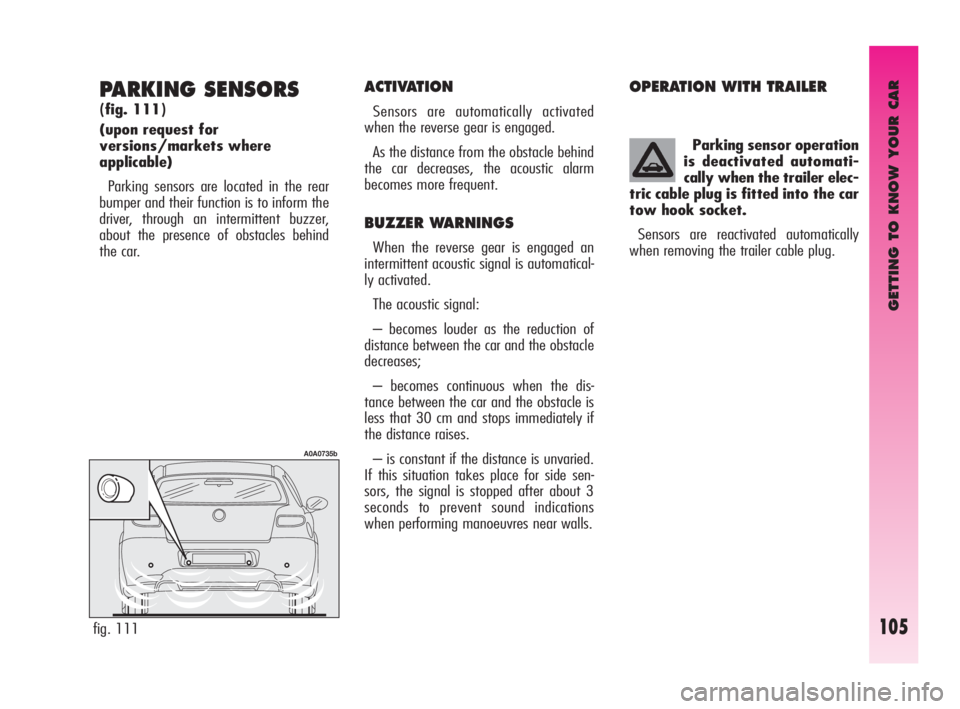
GETTING TO KNOW YOUR CAR
105
PARKING SENSORS
(fig. 111)
(upon request for
versions/markets where
applicable)
Parking sensors are located in the rear
bumper and their function is to inform the
driver, through an intermittent buzzer,
about the presence of obstacles behind
the car.
ACTIVATION
Sensors are automatically activated
when the reverse gear is engaged.
As the distance from the obstacle behind
the car decreases, the acoustic alarm
becomes more frequent.
BUZZER WARNINGS
When the reverse gear is engaged an
intermittent acoustic signal is automatical-
ly activated.
The acoustic signal:
– becomes louder as the reduction of
distance between the car and the obstacle
decreases;
– becomes continuous when the dis-
tance between the car and the obstacle is
less that 30 cm and stops immediately if
the distance raises.
– is constant if the distance is unvaried.
If this situation takes place for side sen-
sors, the signal is stopped after about 3
seconds to prevent sound indications
when performing manoeuvres near walls.
OPERATION WITH TRAILER
Parking sensor operation
is deactivated automati-
cally when the trailer elec-
tric cable plug is fitted into the car
tow hook socket.
Sensors are reactivated automatically
when removing the trailer cable plug.
fig. 111
A0A0735b
Page 110 of 271

GETTING TO KNOW YOUR CAR
108
The wheels should be
locked after a few clicks of
the hand brake. If it does
not occur contact Alfa Romeo Au-
thorised Services to have the hand
brake adjusted.
HAND BRAKE (fig. 115)
The hand brake lever is located between
the two front seats.
To operate the brake when the car is sta-
tionary, pull lever (A) upwards, until the re-
quired braking action is obtained.
When the ignition key is at MAR, the
warning light on the instrument cluster
x
will come on.
fig. 115
A0A0620b
Adjust the beams every
time the load carried
changes.
Correct positions as a function of the load:
– position 0: one or two people occupy-
ing the front seats
– position 1: five people;
– position 2: five people + load in the
boot;
– position 3: driver + 350 Kg load all
stowed in luggage com-
partment
fig. 114
A0A1106b
HEADLIGHT AIMING DEVICE
(fig. 114)
The headlights should be aimed correctly
depending on the car load.
For the required adjustment (only possible
with low beams on), press buttons
▲/▼:
– press button
▲, to increase by one po-
sition (e.g.: 0
➟1➟ 2➟3);
– press button
▼to decrease by one po-
sition (e.g.: 3
➟2➟1➟0);
The display (A), in the tachometer shows
positions during adjustment.
Xenon headlights aiming is automatic, ver-
sions with this optional are therefore not fit-
ted with headlight aiming device.
Page 122 of 271
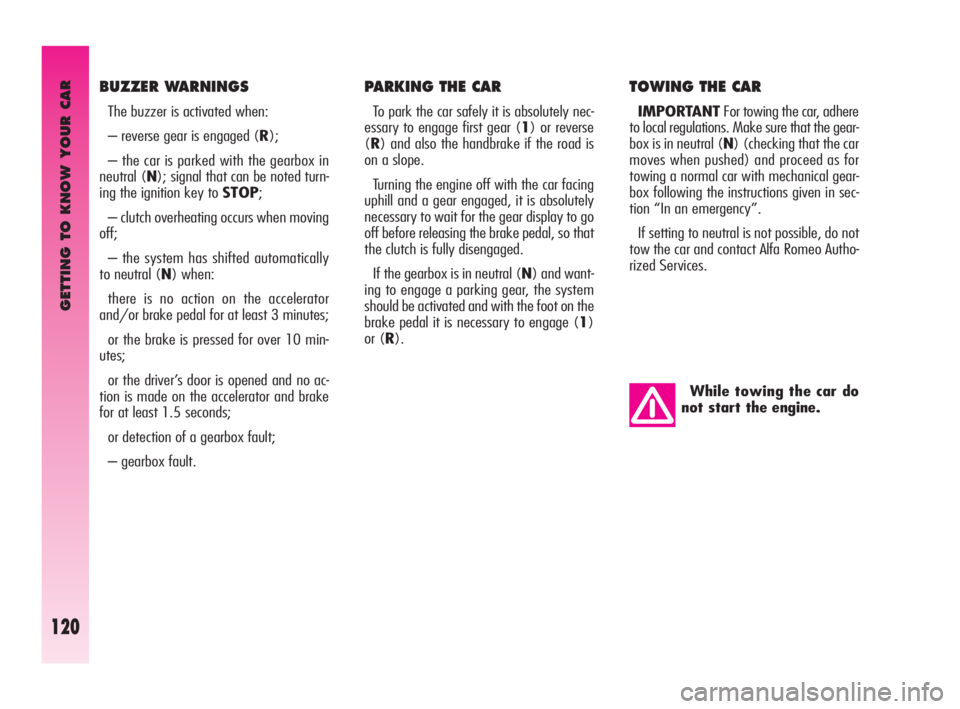
GETTING TO KNOW YOUR CAR
120
PARKING THE CAR
To park the car safely it is absolutely nec-
essary to engage first gear (1) or reverse
(R) and also the handbrake if the road is
on a slope.
Turning the engine off with the car facing
uphill and a gear engaged, it is absolutely
necessary to wait for the gear display to go
off before releasing the brake pedal, so that
the clutch is fully disengaged.
If the gearbox is in neutral (N) and want-
ing to engage a parking gear, the system
should be activated and with the foot on the
brake pedal it is necessary to engage (1)
or (R).
TOWING THE CAR
IMPORTANTFor towing the car, adhere
to local regulations. Make sure that the gear-
box is in neutral (N) (checking that the car
moves when pushed) and proceed as for
towing a normal car with mechanical gear-
box following the instructions given in sec-
tion “In an emergency”.
If setting to neutral is not possible, do not
tow the car and contact Alfa Romeo Autho-
rized Services.
While towing the car do
not start the engine.
BUZZER WARNINGS
The buzzer is activated when:
– reverse gear is engaged (R);
– the car is parked with the gearbox in
neutral (N); signal that can be noted turn-
ing the ignition key to STOP;
– clutch overheating occurs when moving
off;
– the system has shifted automatically
to neutral (N) when:
there is no action on the accelerator
and/or brake pedal for at least 3 minutes;
or the brake is pressed for over 10 min-
utes;
or the driver’s door is opened and no ac-
tion is made on the accelerator and brake
for at least 1.5 seconds;
or detection of a gearbox fault;
– gearbox fault.
Page 135 of 271

GETTING TO KNOW YOUR CAR
133
Check beam aiming every
time the load carried
changes. Correct positions as a function of the load:
– position 0: one or two people occupy-
ing the front seats
– position 1: five people;
– position 2: five people + load in the
boot;
– position 3: driver + 350 Kg load all
stowed in luggage com-
partment
HEADLIGHT ADJUSTMENT
ABROAD
(fig. 149-150)
The dipped-beam headlights are adjusted
for circulation in the country in which the car
is marketed. In countries with opposite cir-
culation, to avoid glaring oncoming vehicles
it is necessary to cover the area of the head-
lights as shown below; this is done using
non-transparent sticker tape.
The illustrations refer to passing from right-
hand drive to left-hand drive.
IMPORTANTXenon headlights aiming
is automatic, versions with this optional are
therefore not fitted with headlight aiming
device.
fig. 149
A0A0199b
fig. 150
A0A0750b
Page 140 of 271

GETTING TO KNOW YOUR CAR
138
SWITCHING ON
THE ASR FUNCTION
The ASR function switches on automati-
cally each time the engine is started.
When travelling the ASR can be switched
off and on again pressing switch (A-fig.
151).
When the function is turned off, the in-
strument panel warning light
Vturns on.
If the function is switched off when trav-
elling, it will turn on again automatically the
next time the engine is started.
fig. 151
A0A1107b
ASR SYSTEM
(Antislip Regulation)
(on request for versions/
markets where applicable)
The ASR function controls the car drive and
cuts in automatically every time one or both
driving wheels slip.
In slipping conditions, tow different control
systems are activated:
1) if slipping involves both driving wheels,
being caused by excessive power transmit-
ted, the ASR device cuts in reducing the pow-
er transmitted by the engine.
2) if slipping involves only one driving
wheel, the ASR system cuts in automatical-
ly braking the wheel that is slipping, with
an effect similar to that of a self-locking dif-
ferential.The performance of the
system in terms of active
safety should not induce
the driver to take pointless and un-
necessary risks. The style of dri-
ving must in any case be adapted
to the conditions of the road sur-
face, visibility and traffic. Road
surface is always the driver’s re-
sponsibility.
The action of the ASR is particularly help-
ful in the following circumstances:
– slipping of the inner wheel on a bend,
due to the effect of dynamic load changes
or excessive acceleration.
– too much power transmitted to the
wheels also in relation to the conditions of
the road safety.
– acceleration on slippery, snowy or frozen
surfaces.
– in the case of loss of grip on a wet sur-
face (aquaplaning).
Page 173 of 271
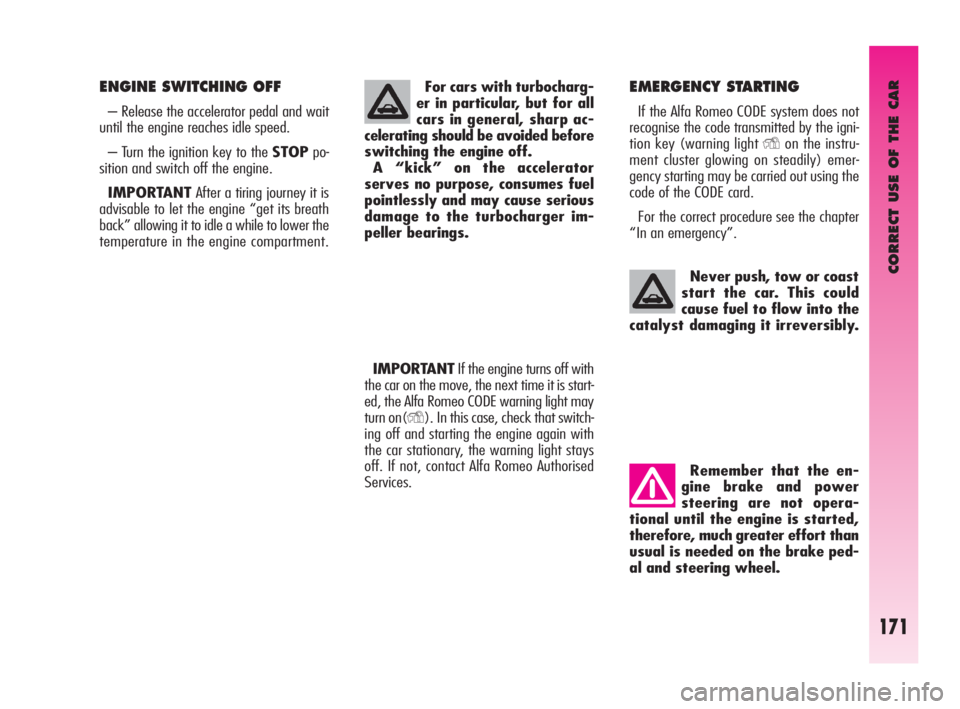
CORRECT USE OF THE CAR
171
Never push, tow or coast
start the car. This could
cause fuel to flow into the
catalyst damaging it irreversibly.
Remember that the en-
gine brake and power
steering are not opera-
tional until the engine is started,
therefore, much greater effort than
usual is needed on the brake ped-
al and steering wheel. For cars with turbocharg-
er in particular, but for all
cars in general, sharp ac-
celerating should be avoided before
switching the engine off.
A “kick” on the accelerator
serves no purpose, consumes fuel
pointlessly and may cause serious
damage to the turbocharger im-
peller bearings.
EMERGENCY STARTING
If the Alfa Romeo CODE system does not
recognise the code transmitted by the igni-
tion key (warning light
Yon the instru-
ment cluster glowing on steadily) emer-
gency starting may be carried out using the
code of the CODE card.
For the correct procedure see the chapter
“In an emergency”.
IMPORTANTIf the engine turns off with
the car on the move, the next time it is start-
ed, the Alfa Romeo CODE warning light may
turn on(
Y). In this case, check that switch-
ing off and starting the engine again with
the car stationary, the warning light stays
off. If not, contact Alfa Romeo Authorised
Services.
ENGINE SWITCHING OFF
– Release the accelerator pedal and wait
until the engine reaches idle speed.
– Turn the ignition key to the STOPpo-
sition and switch off the engine.
IMPORTANTAfter a tiring journey it is
advisable to let the engine “get its breath
back” allowing it to idle a while to lower the
temperature in the engine compartment.
Page 176 of 271
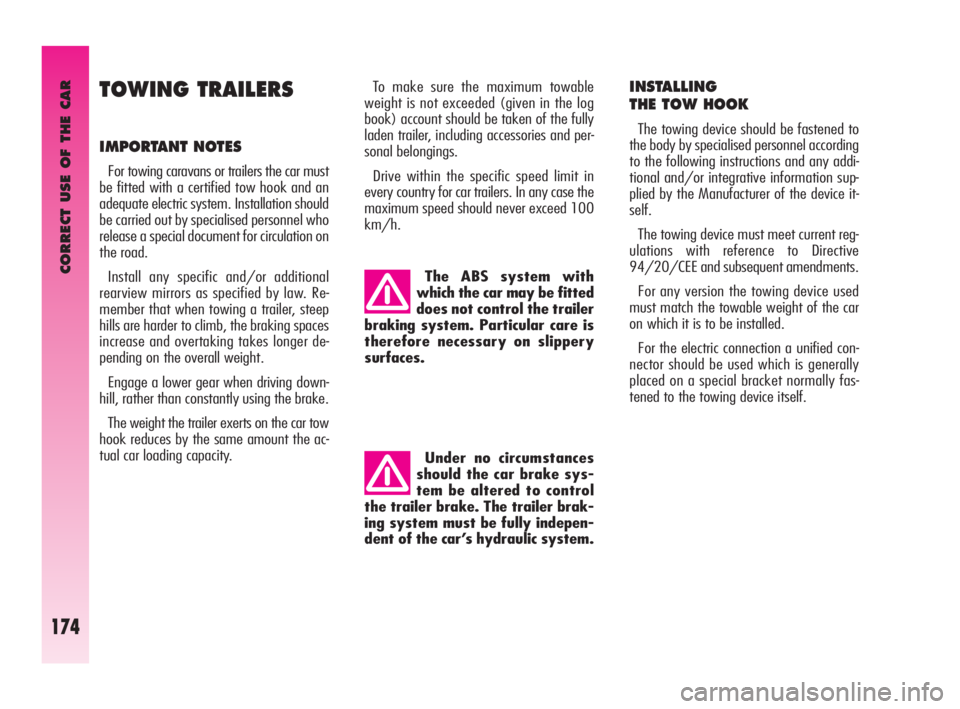
CORRECT USE OF THE CAR
174
TOWING TRAILERS
IMPORTANT NOTES
For towing caravans or trailers the car must
be fitted with a certified tow hook and an
adequate electric system. Installation should
be carried out by specialised personnel who
release a special document for circulation on
the road.
Install any specific and/or additional
rearview mirrors as specified by law. Re-
member that when towing a trailer, steep
hills are harder to climb, the braking spaces
increase and overtaking takes longer de-
pending on the overall weight.
Engage a lower gear when driving down-
hill, rather than constantly using the brake.
The weight the trailer exerts on the car tow
hook reduces by the same amount the ac-
tual car loading capacity.To make sure the maximum towable
weight is not exceeded (given in the log
book) account should be taken of the fully
laden trailer, including accessories and per-
sonal belongings.
Drive within the specific speed limit in
every country for car trailers. In any case the
maximum speed should never exceed 100
km/h.
INSTALLING
THE TOW HOOK
The towing device should be fastened to
the body by specialised personnel according
to the following instructions and any addi-
tional and/or integrative information sup-
plied by the Manufacturer of the device it-
self.
The towing device must meet current reg-
ulations with reference to Directive
94/20/CEE and subsequent amendments.
For any version the towing device used
must match the towable weight of the car
on which it is to be installed.
For the electric connection a unified con-
nector should be used which is generally
placed on a special bracket normally fas-
tened to the towing device itself. The ABS system with
which the car may be fitted
does not control the trailer
braking system. Particular care is
therefore necessary on slippery
surfaces.
Under no circumstances
should the car brake sys-
tem be altered to control
the trailer brake. The trailer brak-
ing system must be fully indepen-
dent of the car’s hydraulic system.
Page 177 of 271

CORRECT USE OF THE CAR
175
For the electrical connection a 7 or 13 pole
12VDC connection must be used (CU-
NA/UNI and ISO/DIN standards) following
any reference instructions given by the car
Manufacturer and/or towing device Manu-
facturer.
Any electric brake should be supplied directly
by the battery through a cable with a cross-
section of no less than 2.5 mm
2. In addition
to the electrical branches, the car electric sys-
tem can only be connected to the supply ca-
ble for an electric brake and to the cable for
an internal light, though not above 15W.
INSTALLATION LAYOUT
(fig. 1)
The tow hook structure must be fas-
tened in the points shown by the sym-
bol
Øusing 4 M8 screws and 7 M10
screws.
The inner plate (2) should have a
minimum thickness of 6 mm.
The inner plate (3) should have a
minimum thickness of 4 mm.
The inner plate (4) should have a
minimum thickness of 5 mm.
The fastening points (1) should be fit-
ted with 25 mm x 6 mm spacers.After fitting, the fasten-
ing screw holes shall be
sealed to prevent exhaust
gas inlet.
IMPORTANTIt is compulsory to fasten
a label (plainly visible) of suitable size and
material with the following wording:
MAX LOAD ON BALL 60 kg.
Page 178 of 271

CORRECT USE OF THE CAR
176fig. 1
A0A0680b
Existing holes
Existing holes
2 M10 screws3 M10 screws4 M8 screws
Standard tow ball2 M10 screwsSECTION A-A Existing holes
Fully laden vehicle
Page 180 of 271
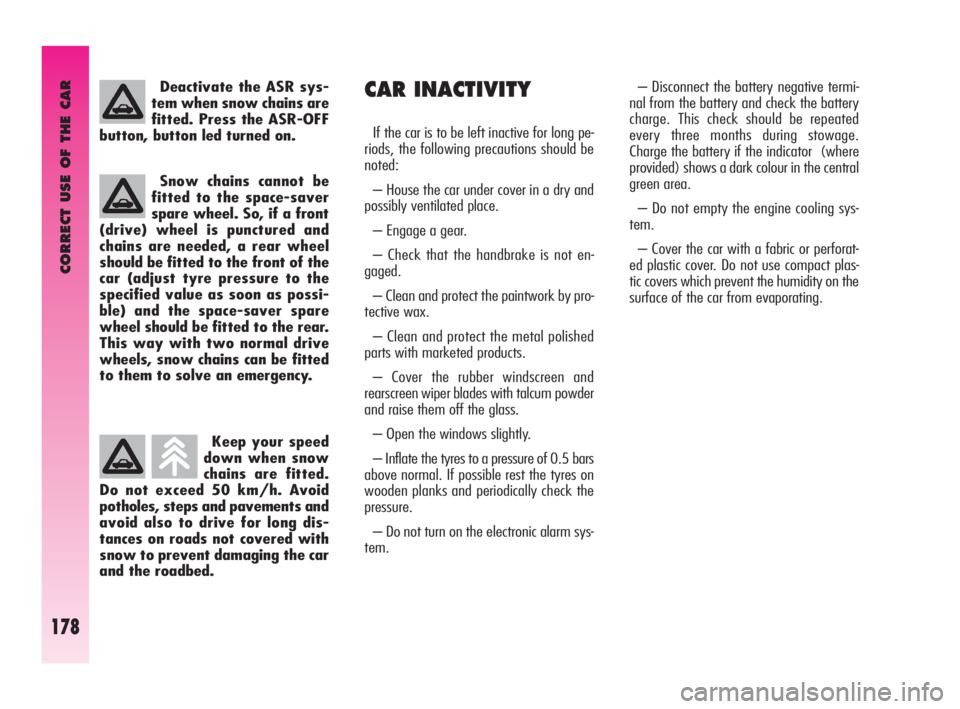
CORRECT USE OF THE CAR
178
Keep your speed
down when snow
chains are fitted.
Do not exceed 50 km/h. Avoid
potholes, steps and pavements and
avoid also to drive for long dis-
tances on roads not covered with
snow to prevent damaging the car
and the roadbed.
CAR INACTIVITY
If the car is to be left inactive for long pe-
riods, the following precautions should be
noted:
– House the car under cover in a dry and
possibly ventilated place.
– Engage a gear.
– Check that the handbrake is not en-
gaged.
– Clean and protect the paintwork by pro-
tective wax.
– Clean and protect the metal polished
parts with marketed products.
– Cover the rubber windscreen and
rearscreen wiper blades with talcum powder
and raise them off the glass.
– Open the windows slightly.
– Inflate the tyres to a pressure of 0.5 bars
above normal. If possible rest the tyres on
wooden planks and periodically check the
pressure.
– Do not turn on the electronic alarm sys-
tem.– Disconnect the battery negative termi-
nal from the battery and check the battery
charge. This check should be repeated
every three months during stowage.
Charge the battery if the indicator (where
provided) shows a dark colour in the central
green area.
– Do not empty the engine cooling sys-
tem.
– Cover the car with a fabric or perforat-
ed plastic cover. Do not use compact plas-
tic covers which prevent the humidity on the
surface of the car from evaporating. Snow chains cannot be
fitted to the space-saver
spare wheel. So, if a front
(drive) wheel is punctured and
chains are needed, a rear wheel
should be fitted to the front of the
car (adjust tyre pressure to the
specified value as soon as possi-
ble) and the space-saver spare
wheel should be fitted to the rear.
This way with two normal drive
wheels, snow chains can be fitted
to them to solve an emergency.
Deactivate the ASR sys-
tem when snow chains are
fitted. Press the ASR-OFF
button, button led turned on.